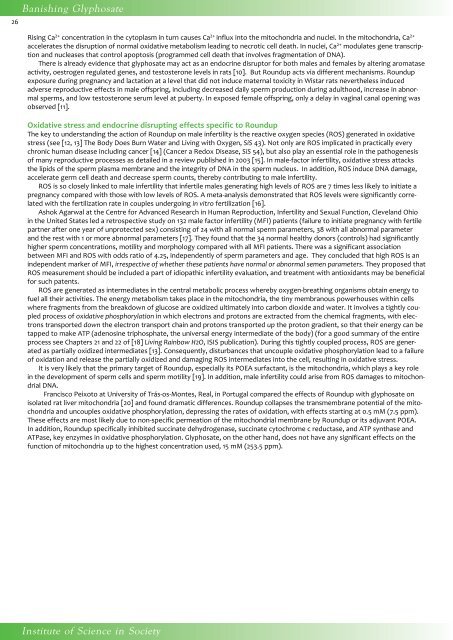Banishing Glyphosate
BanishingGlyphosate
BanishingGlyphosate
Create successful ePaper yourself
Turn your PDF publications into a flip-book with our unique Google optimized e-Paper software.
26<br />
<strong>Banishing</strong> <strong>Glyphosate</strong><br />
Rising Ca 2+ concentration in the cytoplasm in turn causes Ca 2+ influx into the mitochondria and nuclei. In the mitochondria, Ca 2+<br />
accelerates the disruption of normal oxidative metabolism leading to necrotic cell death. In nuclei, Ca 2+ modulates gene transcription<br />
and nucleases that control apoptosis (programmed cell death that involves fragmentation of DNA).<br />
There is already evidence that glyphosate may act as an endocrine disruptor for both males and females by altering aromatase<br />
activity, oestrogen regulated genes, and testosterone levels in rats [10]. But Roundup acts via different mechanisms. Roundup<br />
exposure during pregnancy and lactation at a level that did not induce maternal toxicity in Wistar rats nevertheless induced<br />
adverse reproductive effects in male offspring, including decreased daily sperm production during adulthood, increase in abnormal<br />
sperms, and low testosterone serum level at puberty. In exposed female offspring, only a delay in vaginal canal opening was<br />
observed [11].<br />
Oxidative stress and endocrine disrupting effects specific to Roundup<br />
The key to understanding the action of Roundup on male infertility is the reactive oxygen species (ROS) generated in oxidative<br />
stress (see [12, 13] The Body Does Burn Water and Living with Oxygen, SiS 43). Not only are ROS implicated in practically every<br />
chronic human disease including cancer [14] (Cancer a Redox Disease, SiS 54), but also play an essential role in the pathogenesis<br />
of many reproductive processes as detailed in a review published in 2003 [15]. In male-factor infertility, oxidative stress attacks<br />
the lipids of the sperm plasma membrane and the integrity of DNA in the sperm nucleus. In addition, ROS induce DNA damage,<br />
accelerate germ cell death and decrease sperm counts, thereby contributing to male infertility.<br />
ROS is so closely linked to male infertility that infertile males generating high levels of ROS are 7 times less likely to initiate a<br />
pregnancy compared with those with low levels of ROS. A meta-analysis demonstrated that ROS levels were significantly correlated<br />
with the fertilization rate in couples undergoing in vitro fertilization [16].<br />
Ashok Agarwal at the Centre for Advanced Research in Human Reproduction, Infertility and Sexual Function, Cleveland Ohio<br />
in the United States led a retrospective study on 132 male factor infertility (MFI) patients (failure to initiate pregnancy with fertile<br />
partner after one year of unprotected sex) consisting of 24 with all normal sperm parameters, 38 with all abnormal parameter<br />
and the rest with 1 or more abnormal parameters [17]. They found that the 34 normal healthy donors (controls) had significantly<br />
higher sperm concentrations, motility and morphology compared with all MFI patients. There was a significant association<br />
between MFI and ROS with odds ratio of 4.25, independently of sperm parameters and age. They concluded that high ROS is an<br />
independent marker of MFI, irrespective of whether these patients have normal or abnormal semen parameters. They proposed that<br />
ROS measurement should be included a part of idiopathic infertility evaluation, and treatment with antioxidants may be beneficial<br />
for such patents.<br />
ROS are generated as intermediates in the central metabolic process whereby oxygen-breathing organisms obtain energy to<br />
fuel all their activities. The energy metabolism takes place in the mitochondria, the tiny membranous powerhouses within cells<br />
where fragments from the breakdown of glucose are oxidized ultimately into carbon dioxide and water. It involves a tightly coupled<br />
process of oxidative phosphorylation in which electrons and protons are extracted from the chemical fragments, with electrons<br />
transported down the electron transport chain and protons transported up the proton gradient, so that their energy can be<br />
tapped to make ATP (adenosine triphosphate, the universal energy intermediate of the body) (for a good summary of the entire<br />
process see Chapters 21 and 22 of [18] Living Rainbow H2O, ISIS publication). During this tightly coupled process, ROS are generated<br />
as partially oxidized intermediates [13]. Consequently, disturbances that uncouple oxidative phosphorylation lead to a failure<br />
of oxidation and release the partially oxidized and damaging ROS intermediates into the cell, resulting in oxidative stress.<br />
It is very likely that the primary target of Roundup, especially its POEA surfactant, is the mitochondria, which plays a key role<br />
in the development of sperm cells and sperm motility [19]. In addition, male infertility could arise from ROS damages to mitochondrial<br />
DNA.<br />
Francisco Peixoto at University of Trás-os-Montes, Real, in Portugal compared the effects of Roundup with glyphosate on<br />
isolated rat liver mitochondria [20] and found dramatic differences. Roundup collapses the transmembrane potential of the mitochondria<br />
and uncouples oxidative phosphorylation, depressing the rates of oxidation, with effects starting at 0.5 mM (7.5 ppm).<br />
These effects are most likely due to non-specific permeation of the mitochondrial membrane by Roundup or its adjuvant POEA.<br />
In addition, Roundup specifically inhibited succinate dehydrogenase, succinate cytochrome c reductase, and ATP synthase and<br />
ATPase, key enzymes in oxidative phosphorylation. <strong>Glyphosate</strong>, on the other hand, does not have any significant effects on the<br />
function of mitochondria up to the highest concentration used, 15 mM (253.5 ppm).<br />
Institute of Science in Society


